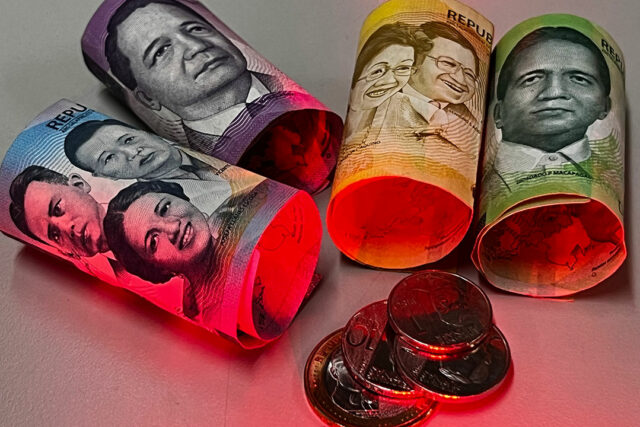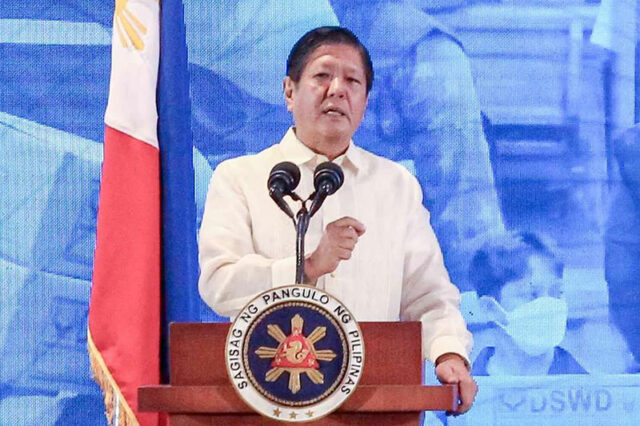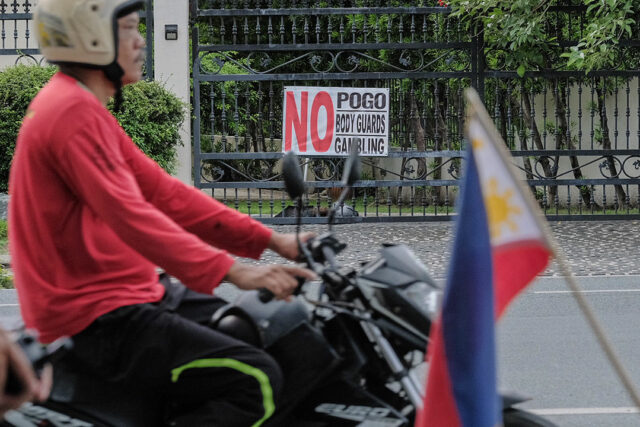By Kenneth Christiane L. Basilio and Chloe Mari A. Hufana, Reporters
MORE than four in 10 Filipinos are not satisfied with the performance and leadership of President Ferdinand R. Marcos, Jr., a recent WR Numero Research poll found, which could be linked to his escalating feud with Vice-President (VP) Sara Duterte-Carpio and his administration’s response to national issues.
In its February survey, WR Numero found 43% of Filipinos said they are dissatisfied with Mr. Marcos, with 30% finding the Philippine leader’s performance satisfactory. About 27% of Filipinos remain on the fence about his performance.
 Mr. Marcos’ score dipped by 15% from his 45% performance rating in WR Numero Research’s September 2024 poll, showing a declining trend in his satisfaction rating based on the pollster’s previous surveys. His satisfaction rating in December 2023 was 65%.
Mr. Marcos’ score dipped by 15% from his 45% performance rating in WR Numero Research’s September 2024 poll, showing a declining trend in his satisfaction rating based on the pollster’s previous surveys. His satisfaction rating in December 2023 was 65%.
The President’s declining performance ratings were caused by his escalating political feud with the Dutertes and discontent with his government’s handling of the country’s pressing issues, such as persisting inflation, said Cleve V. Arguelles, chief executive officer and president of Philippine think-tank WR Numero Research.
“We think that this really has something to do with the Marcos-Duterte divide, and in relation to that, the divide between the two leaders is really unpopular,” he said in a media briefing.
“There’s still a lot of disapproval in terms of how the Marcos administration is responding to some of the key issues in the country,” he added.
The Marcoses and Dutertes had a political falling out owing to policy differences, with Mr. Marcos veering away from the key policies of ex-President Rodrigo R. Duterte, including standing up to China and pursuing closer security ties with western nations such as the US and investigating his predecessor’s bloody drug war.
The feud between two of the country’s most influential clans reached a new peak in early 2025 after Ms. Duterte was impeached by the House of Representatives, who is headed by Speaker Ferdinand Martin G. Romualdez, the President’s cousin.
The dissatisfaction rating of Ms. Duterte was 28.6% in the same survey, while 41% found her performance satisfactory. Three of 10 Filipinos are unsure about her performance.
“The decline in President Marcos’ ratings is faster, and a lot of that has to do with regional political loyalties,” said Mr. Arguelles in Filipino. “Mindanao remains a Duterte stronghold, and the Vice-President can still maintain at least 40% satisfaction ratings despite losing support elsewhere.”
“On the other hand, the President relies on areas like Metro Manila, which is traditionally a very fickle-minded constituency without much traditional political loyalty. They can be swayed by political narratives, which is why Mr. Marcos is more affected,” he added.
The President received a 31.2% approval score in Metro Manila and 17% in Mindanao, while Ms. Duterte garnered a 29.2% satisfaction rating in Metro Manila and 68% in Mindanao.
VP IMPEACHMENT
Meanwhile, Filipinos are largely divided regarding Ms. Duterte’s impeachment at the House, with 47% opposing it and 33% in support. One-fifth or 20% remain undecided on her indictment.
“This indicates that public opinion may shift towards either side, whether supportive or opposing the House impeachment of the Vice-President,” said Mr. Arguelles.
The same survey showed that four of 10 Filipinos remain undecided on how the Senate should rule in Ms. Duterte’s impeachment trial. Over 30% of Filipinos believe the Senate should acquit her, while 23.3% say she should be convicted.
The majority of Filipinos — 56.1% — also said that Mr. Marcos should remain neutral on the Vice-President’s looming ouster trial. Results showed that one in five Filipinos believe the President should dissuade his senate allies from convicting Ms. Duterte, with only 19.7% saying he should rally for her conviction.
The House on Feb. 5 impeached Ms. Duterte for alleged abuse of power and constitutional violations stemming from her use of confidential funds, paving the way for her trial by the Senate.
The ouster charges against the embattled Vice-President were filed and signed by 215 congressmen, more than the one-third legal requirement before it can be sent to the Senate, which will try her in an impeachment court. Several congressmen will be serving as impeachment prosecutors.
The complaint consisted of seven articles of impeachment, including allegations of plotting the assassination of the President, misusing secret funds, amassing unexplained wealth and committing acts of destabilization.
Congressmen sent the impeachment bill to the Senate on the last day of the congressional session, before lawmakers took a four-month break for the midterm elections in May. Filipinos will pick a new set of congressmen, 12 of the 24-member Senate and other local government officials on May 12.
The May polls will serve as a referendum on Mr. Marcos’s popularity and offer him an opportunity to consolidate power and groom a successor for 2028.
SENATE RACE
In the same survey, WR Numero found at least eight senatorial bets of the Marcos-backed Alyansa Para sa Bagong Pilipinas are within the winning margin of the 12-seat Senate race.
Party-list Rep. Erwin T. Tulfo remains the Senate frontrunner, as 46.5% of Filipinos said they will vote for him. He is followed by Senator and re-electionist Manuel M. Lapid (37.1%), sharing the second-fourth place with ex-Senator Ramon “Bong” B. Revilla, Jr. (36.1%) and Senator Pilar Juliana “Pia” S. Cayetano (35.8%).
Ex-Senator Vicente C. Sotto III (32.4%), Makati City Mayor Mar-Len Abigail S. Binay (32.3%), broadcaster Bienvenido T. Tulfo (32.1%), and ex-Senator Panfilo M. Lacson (30.8%) shared the fifth-seventh position.
Senators Christopher Lawrence T. Go (30%) and Ronald M. Dela Rosa (29.5%) and ex-Senator Emmanuel D. Pacquiao, Sr. (26.9%) are tied for the eight-10th position.
Television personality Wilfredo B. Revillame (26.5%) and ex-Senators Paolo Benigno A. Aquino (25.2%) and Francis Pancratus N. Pangilinan (24.9%) topped the 11th-14th position.
“Is this a referendum on the administration? In my view, partly yes… But again, it’s hard to give Mr. Marcos all the credit for this because most of the administration candidates aren’t strictly his. These are old names in Philippine politics,” Mr. Arguelles told BusinessWorld after the media briefing.
“Those names, if you look at them, aren’t strictly Marcos partisans. These are big names, re-electionists and incumbents,” he added.
The pollster interviewed 1,814 Filipinos across the country from February 10 to 18 with an error margin of ±2%.
Eight admin-backed senatorial candidates likewise dominated the Social Weather Station’s (SWS) latest pre-election survey.
The nationwide poll, conducted from Feb. 15 to 19, in collaboration with the Stratbase Group, surveyed 1,800 registered voters and has a ±2.31% margin of error.
It comes just days after the official campaign period kicked off on Feb. 11.
ACT-CIS Rep. Tulfo retained his lead in the race, securing 45% voter preference. Behind him, the battle for Senate seats remains fluid.
Mr. Go climbed to second place with 38%, edging out Mr. Lapid, who holds steady in third with 36%.
Mr. Sotto slipped from second to a shared fourth-fifth place as support for him declined from 38% to 34%. He is now tied with broadcaster Mr. Tulfo, who saw a modest rise to fourth place from sixth with the same 34% backing.
The biggest gainer in SWS’s February poll is Mr. Revilla, Jr., who jumped from the lower tier (11th-13th place) to a more secure 6th-7th ranking, enjoying a four-percentage-point increase to 33%.
He shared the spot with Ms. Cayetano, who maintained her position.
Meanwhile, Mr. Lacson saw his ranking slide to the 8th-9th place from 5th as his support dipped to 32%, now tied with Mr. Dela Rosa, who climbed one notch higher.
Mr. Pacquiao and Ms. Binay both saw their rankings drop, landing in the 10th-12th bracket.
Mr. Revillame remains on the edge of the Senate’s “magic 12” with 30% support.
Former Senator Francis Pancratus N. Pangilinan took a significant hit, sliding from 11th to 13th to 15th place as support fell from 29% to 22%. His political ally, former Senator Paolo Benigno A. Aquino IV, lost four percentage points but retained his position at 17th.
Meanwhile, candidates backed by former President Rodrigo R. Duterte’s PDP-Laban remain far from securing Senate seats as their polling numbers continue to lag.
While administration-backed bets continue to dominate, opposition candidates remain outside the winning circle, reinforcing a trend seen in previous elections.
Political science lecturer at the Ateneo de Manila University Hansley A. Juliano attributed this to the opposition’s continued reliance on an “institution-based and institution-identified reform-oriented campaign” that struggles to compete with entrenched patronage networks.
“Opposition candidates continue to be seen as “losing propositions” for 9 years now, which only solidifies the longer it persists,” he told BusinessWorld in a Facebook Messenger chat.
At the same time, the weakening of civil society networks — historically key to mobilizing opposition support — has further eroded their electoral base, he noted.
Once-powerful institutions such as universities, mainstream media, and the Catholic Church are struggling to assert influence while evangelical networks and alternative media spaces shape new voter blocs, he added.
If the current lineup holds, Philippine politics is likely to remain defined by the Marcos Jr. vs. Duterte rivalry, leaving little space for opposition resurgence, according to the academic.
The opposition’s failure to adapt to new political realities — where name recall, media influence, and local machinery outweigh policy-driven campaigns — continues to hurt their chances, he added.














